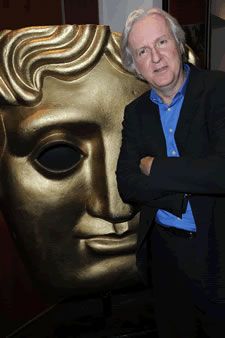
James Cameron at the BAFTA event
Despite the phenomenal amount of research that went into making Titanic, legendary filmmaker (and reputed perfectionist) James Cameron has told a London audience there were “a few little mistakes” in his award-winning epic.
“We went back to Titanic subsequently with these robotic vehicles and explored the interior, and found out that some of the woodwork was a little different and some of the patterns on some of the doors were a little different,” he reveals. “I really felt for a time like I should re-shoot the movie.”
There’s some nervous laughter from the crowd as we try to work out whether he’s joking.
“Does that really irritate you?” asks the host of Friday’s film event*.
“No,” laughs James, cracking a huge grin. “I just wanted to see if you’d believe that!”
Though it’s good to know he’s still got a sense of humour, it’s clear that filmmaking is something James takes seriously – and you don’t even need to glance at his impressive CV to know that his passion has more than paid off. His credits include several sci-fi classics (The Terminator, Aliens, The Abyss and Terminator 2: Judgment Day) and action-comedy True Lies, not to mention the smash-hit Titanic, which broke box-office records around the world and bagged a staggering 11 Oscars. And with hotly anticipated new release Avatar out this week, chances are he’ll soon have another huge hit on his hands.
Born in 1954 in Ontario, Canada, James’s interest in movies was sparked at an early age. “When I was around seven-ish, I saw Mysterious Island, which had fantastic creature effects in it – really pretty mind-blowing stuff in its day. And I recall that my response to that was to draw. Whenever I saw something that made a strong impression on me I had to draw it, but I wouldn’t just draw the thing itself – I would start to embellish and create my own stories around it.”
In his teens, another movie that had an effect on him (literally!) was 2001: A Space Odyssey. “I had a strange reaction,” he says. “The whole slit-scan sequence induced a sense of vertigo. I just felt like I was falling – I must have been very impressionable to the physiological effects of movies, and I actually went outside, sat down on the kerb in the middle of the day in Toronto and promptly threw up! It didn’t mean I didn’t like the film – I was intrigued.”
Yet despite his fascination with filmmaking, James says that throughout his high school years he never considered it as a career option. Instead, he initially went on to study physics and then switched to English – but ultimately the lure of the cinema beckoned...
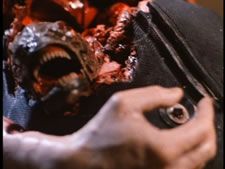
In the early Eighties, James spent some time working for famous producer Roger Corman, and made his feature film directorial debut with Piranha II: The Spawning (incidentally, the plot follows a scuba diving instructor – spot a watery trend emerging…). However, it was his second feature, The Terminator, that really earmarked him as a rising talent.
James reveals how the initial idea came to be: “I was in Rome, I was broke, I had a high fever and I was just having these weird dreams. I had this image – a kind of cold skeleton death image coming out of a fire, kind of phoenix-like – and I just got up and sketched it. Around the nucleus of that I started to create a story and back-fill – What is it? Where did it come from? Who’s it after? – and it all sort of fell into place fairly quickly.
“I went back to LA and was sleeping on a friend’s couch, and somehow managed to talk an agent into representing me. I told him this idea I had for a hitman from the future that comes back to kill this girl who’s nobody in the present but will be very important in future events, and he said: ‘Terrible idea – don’t do it!’ So I fired him.”
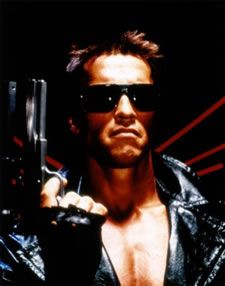
Fortunately for sci-fi fans everywhere, the project eventually got the green light – though the casting could have turned out somewhat differently… While Arnold Schwarzenegger has since become synonymous with the titular character, James reveals that an Orion exec originally wanted to cast the star in the role of Kyle Reese. “He called me up and said, ‘Are you sitting down? I’ve got this movie cast! I met these two guys at a party and they’re gonna be perfect. The Terminator will be played by OJ Simpson and Reese will be played by Arnold Schwarzenegger.
“I didn’t think that was such a great idea even before I knew that OJ Simpson was probably not the best choice for other reasons, but I didn’t feel comfortable just blowing off the studio head’s brilliant idea, so I thought I’d better meet with one of these guys. So I went and met with Arnold for lunch and as I left my apartment I said to my roommate, ‘I have to go pick a fight with Conan,’ because I figured if we had creative differences I could say it didn’t work out. Of course, he was utterly charming and passionate about the script. He was supposed to be going for the other character that Michael Biehn played, but I’m watching him the whole time thinking, ‘This guy’s The Terminator if I ever saw one.’”
Following the movie’s critical and public success, more sci-fi films followed, including Aliens, The Abyss and of course Terminator 2: Judgment Day, which fared even better at the box office than the original. However, James reveals that he had to change his intended ending at the very last minute.
“I had the film done – I think we had one or two reels still to mix – and we were about to deliver the movie in a few days,” he explains. “We did a preview screening at George Lucas’s ranch and bussed people in from San Francisco. The cards came back that they loved the movie, but they were very definitive that they hated the ending. It was kind of a ‘happy ending’ if you will, it was like the alternate future if Judgment Day hadn’t happened, what would have happened to Sarah and what would have happened to John.”
With so little time left, James’s options were limited. “I couldn’t re-shoot the ending – we were days away from delivery – so I just cut it off,” he continues. “I found a shot of the white line of a highway from the tail end or the head end of a shot earlier in the movie when they’re driving to the Cyberdyne lab. It’s just a white line going through the camera. And I found a piece of it just long enough, and wrote a voiceover based on how long the piece of film was that we had – we didn’t even have time to go out and get a shot of a highway. The voiceover just happened to fit, we flew Linda [Hamilton, whom he later married and divorced] out to record the voiceover, slapped it in the movie and delivered it to the lab I think two days later. That’s the end of the movie and it worked beautifully – I should have thought of it in the first place!”
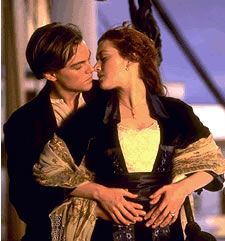
Having made a name for himself as a skilled sci-fi and action director, James’s decision to make a period love story – which he pitched to Fox as “Romeo and Juliet on the Titanic” – may have initially seemed a strange choice. However, as the avid diver explains, it was all part of a wider plan: “My real goal was to actually go dive the shipwreck – making the movie was kind of secondary. People make decisions for strange reasons.
“My pitch on that had to be a little more detailed, so I said, ‘Look, we’ve got to do this whole opening where they’re exploring the Titanic and they find the diamond, so we’re going to have all these shots of the ship. Now we can either do them with elaborate models and motion control shots and CG and all that, which will cost X amount of money – or we can spend X plus 30 per cent and actually go shoot it at the real wreck. It will be a publicity coup; you can basically take it from the marketing budget.’ And they said Ohhh-kay. I guess they figured that if I did the expedition at the beginning, if I got killed they wouldn’t have spent that much, and if it worked they’d have great publicity.”
As he talks about the movie, which garnered more than 80 awards, you can’t help but be struck by his enthusiasm and meticulous attention to detail. “I read everything I could,” he says. “I created an extremely detailed timeline of the ship’s few days and a very detailed timeline of the last night of its life. And I worked within that to write the script, and I got some historical experts to analyse what I’d written and comment on it, and I adjusted it.
“I felt that when we started the production we really had a very clear picture of what happened on the ship that night. I had a library that filled one whole wall of my writing office with Titanic stuff, because I wanted it to be right, especially if we were going to dive to the ship. That set the bar higher in a way – it elevated the movie in a sense. We wanted this to be a definitive visualisation of this moment in history as if you’d gone back in a time machine and shot it.”
Needless to say, such a complex project was not without its challenges. “I remember the last day of shooting – we’d shot for 22 hours straight, we just had to finish everything up – and the last shot was the shot of the bridge flooding with the captain on there,” says James.
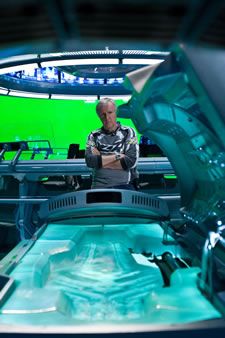
“I was in a wetsuit with breathing gear, and I had hockey guards on my shins in case when the glass broke it came in, and I was just thinking, ‘OK, I’ve been up for 36 hours straight, I’m 20ft underwater, they’re about to blow all this glass, this room is going to implode.’ And it’s like ‘Lord, take me now – this would be a really good time, because we’re over-budget, it’s a chick flick where everybody dies at the end, and I don’t have time to finish the movie!’”
But finish the movie he did – and the rest, as they say, is history. However, once you’ve made history so spectacularly, where do you go from there?
After the amazing success of Titanic, James seemed to disappear off our radar for a spell, though he denies any suggestion that he was “quaking in his boots” about making his next movie. “I basically got hooked on deep ocean exploration and there was a thrill in that that was greater than the glitz of a red-carpet, or winning an Academy Award,” he says. “I don’t mean to diminish them because they’re wonderful experiences, but there was something very real yet in a science fiction/fantasy kind of way about exploring inner space. I always wanted to go to space; I couldn’t do that, but I could go to the bottom of the ocean.”
He made four documentary films over a five-year period, and says he also enjoyed spending time with his family. “I knew that the kind of commitment that I made to a movie didn’t allow me to have any free time; I would just work seven days a week and I wasn’t willing to do that either. So everything just kind of worked out the way it was meant to work out from my perspective. From the external view, it seems like I just went away and then came back with Avatar.”
Which brings us nicely to James’s latest production, the eyewateringly expensive 3D adventure which has been four years in the making (although he came up with the concept more than a decade ago). Though it clearly has huge expectations to live up to, James says the external pressure isn’t any greater than the pressure he puts on himself. “You’re really always competing with yourself,” he claims. “I’ve always tried to approach my work with a standard of excellence and to live up to my own expectations. I think that’s the healthiest way to be about it. Certainly you’re aware of the expectations from outside, but I can’t imagine that it would make me any harder on myself in terms of the thought process and the decision-making process than I already am.”

If the early reviews are anything to go by, he shouldn’t have much to worry about. Though we were only treated to a glimpse of the movie on Friday, the clip we saw was astonishing, and would certainly seem to justify the claims that this could be the future of cinema as we know it. It reminded me of watching Jurassic Park for the first time as a youngster and being mesmerised by all the amazing creatures – only this time, the action’s not just coming to life on screen, it’s coming right out of the screen.
And with his latest blockbuster finally completed, James says he hasn’t made a decision on his next movie yet: “I’m going to let the dust clear on Avatar and get a little rest time in.” Whatever it is, we can’t wait to see what he’ll come up with…
* James Cameron was speaking at an Alfred Dunhill BAFTA Life in Pictures event. View videos from previous events online at www.bafta.org
Avatar is out at cinemas across the UK now. Read what the cast had to say about the film here.





















